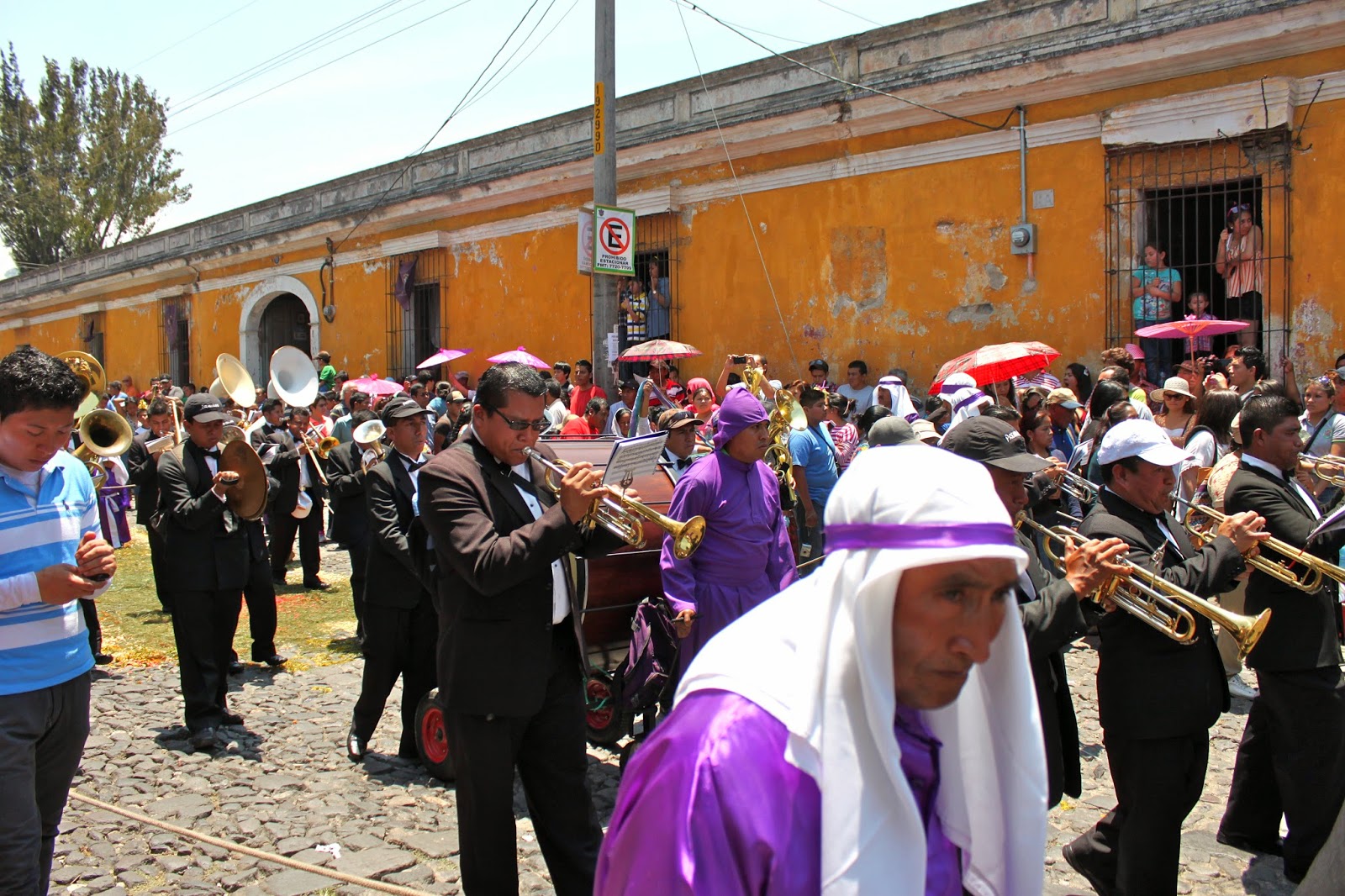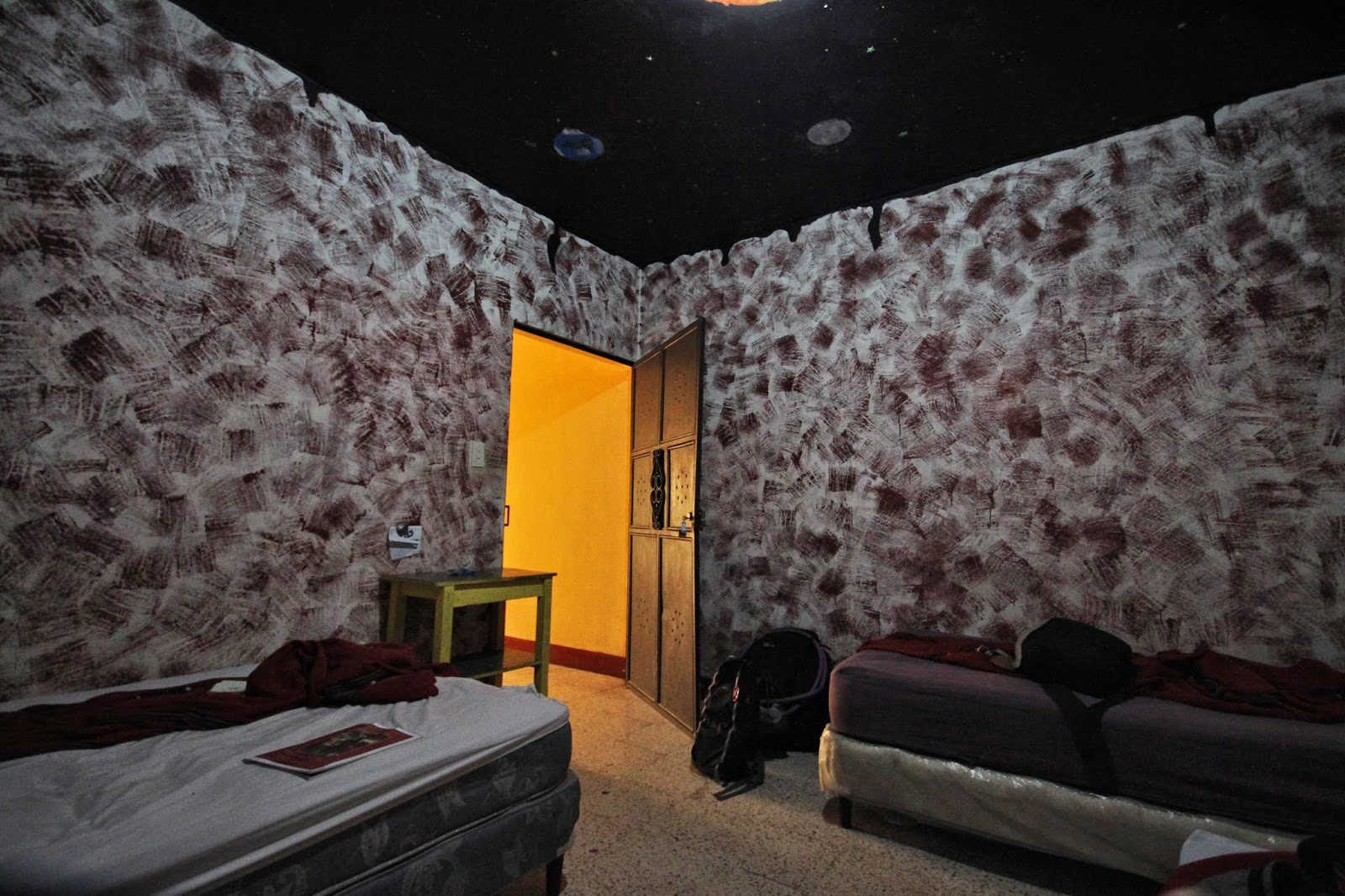Antigua = ancient or antique. This charming & colorful cobblestoned colonial town is a glimpse into the past as many of Central America's cities are I'm learning. Antigua was once the capital of Guatemala, but after several earthquakes hit back in the 1700's, destroying most of the buildings, the capital was eventually moved to the present day capital, Guatemala City. It's about a 30-40 minute ride by chicken bus from Guate. I unfortunately failed in having my camera with me when we did most of our moseying about the city, so, not seen in these pictures are the many ruins of churches that are sprinkled throughout the city and stand, although with cracked and crumbling facades, amongst the newer, colorful buildings.
There are no traffic lights, stop signs, or any other form of traffic regulation in Antigua and many days we were here certain streets were closed off entirely to any vehicles.
Like many of the places we've seen thus far, the city is surrounded by volcanoes. Three large volcanoes decorate Antigua's horizon. The most noticeable of them being El Volcán de Agua to the south of the city. It stands at 12,356 ft. high. When the Spanish arrived, the native people of the land called Volcán de Agua Hunapú, and many still do. Antigua was actually the 3rd capital of Guatemala and became so after a volcanic mudflow buried the previous capital.
As we wandered about we discovered an incredible array of food vendors all set up in one of Antigua's plazas. This was definitely where the locals came to socialize and feast in the early evening. We joined in and tried just about everything there was to offer over the span of the next few days.


La Merced Church - the food vendors were all next to this church here, which had one heck of a something going on inside. We were here in the weeks leading up to Easter with Palm Sunday approaching. This is a very sacred time for many of the people here. Stepping into this church felt like walking into a haunted house of sorts, with the lights dimmed and a deep voice echoing through the sound system. The altar was lit up with red, green, and blue lights. The whole things was honestly a bit creepy feeling, but that's just my opinion.

We exited the church, however, and caught one heck of a sunset.
One of Antigua's many notable structures, El Arco de Santa Catalina & Volcán de Agua looming beyond.
El Parque Central is in the heart of the city and another popular hangout. The streets are lined with trees and vendors pass by selling anything from ice cream and individual cigarettes to hammocks and scarves of every color.
Above is the Cathedral of San José. Parades were beginning to pass through the city with floats and small marching bands. These are another part of Antigua's elaborate religious celebrations during Lent. People gathered to watch and the float was eventually brought up the steps and into the San José Cathedral.
This reconstructed fountain is a common meeting place.
We woke up on Palm Sunday to find that the streets were bustling with people busy preparing for the day's big events. The streets were all closed off to cars (and any left behind were quickly towed away) as locals, tourists and of course eager vendors looking to make a sale filled the streets.
We watched in amazement as elaborate carpets were made before our eyes; using dyed sawdust, flowers, pine needles and even fruits and vegetables to create masterpieces.
The details were incredible.

Many stopped to watch as the artists worked away under the harsh rays of the early afternoon sun.

One of the most elaborate and a group favorite.



We didn't really know what was going on at any point and were admiring the carpets when we realized we were more or less the only ones in the street as everything got quiet and we heard the thumping of drums approaching. The procession was beginning.
We quickly jumped up on the sidewalk and quickly realized we weren't going anywhere anytime soon. We packed in as the purple swarm came carrying wooden floats that appeared to be quite heavy. The beautiful carpets were trampled and slowly destroyed.

Bands followed with eerie, droning music.
The girls followed, appearing to be rather young, dressed in black and white with black veils hoisting La Virgen Fiel (the faithful virgen) upon their shoulders. Some of the girls appeared uninterested entirely while others kept their eyes closed, seemingly very somber.
We eventually escaped the crowds, rather desperately actually, when we realized there wasn't simply one parade but endless parades. They marched down every street into the late evening. We found refuge from the less than pleasant music, heat, and claustrophobic crowds on a rooftop terrace where chicken wings and tequila lemonades awaited us.
As far as lodging goes, here's some photos from our lovely and cozy hostel, La Casa Amarilla, which I would highly recommend to anyone visiting Antigua. It was Q110/night (an incredible breakfast spread included) - which is a bit higher than we've been paying but because of Holy Week approaching, a spike in prices was the norm all over Central America.

They had a great rooftop terrace with views of El Volcán de Agua as well as the other two to the west, Acatenango & El Volcán del Fuego. Fuego is famous for its near constant activity. Steam and gas escape it daily, with the most recent larger eruption occurring in 2012.
Agua
Fuego & Acatenango
We caught a glimpse of Fuego's fury escaping while watching the creation of the carpets on the streets below our hostel.

More of Casa Amarilla AND...
before finding Casa Amarilla, we managed to stay in one of the creepiest hostels we've yet encountered.
Here's a glimpse:
The room was lit with one horrible, uncovered lightbulb, providing the worst light ever. Also, look at the black ceiling paint bleeding down onto the red sponged walls! But wait, at least we had a window, err....
Dungeon door and peephole also included. Cheers to hostel hopping and cheap living!



































No comments:
Post a Comment